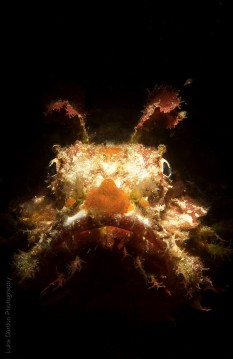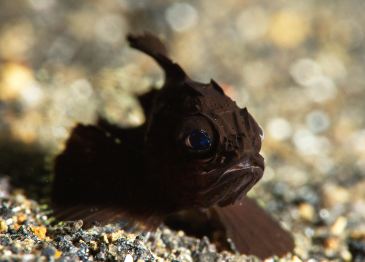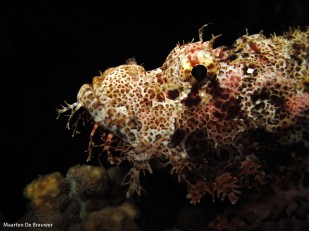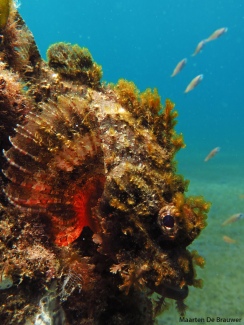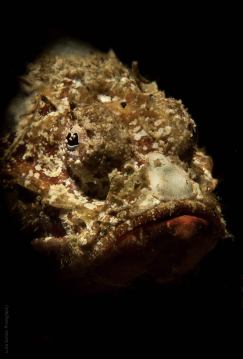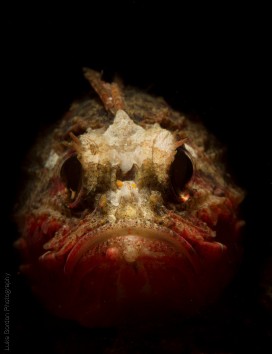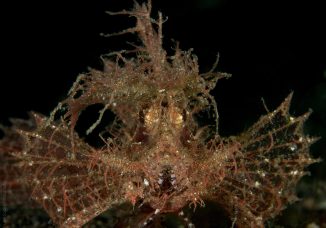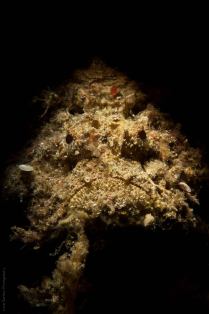Time to ramp up the critter section after the Winged Pipefish and juvenile Batfish. Both of the previous critters are generally considered to look pretty or at least kind of cute, which is often not the case for members of the Scorpionfish family.
Ever since I’ve started diving I’ve been intrigued by Scorpionfishes and I never get bored looking at them. They are well camouflaged predatory fishes that lay on the bottom (true “benthic” critters!), waiting for unsuspecting prey to pass by. Or maybe they just use that as an excuse to chill out most of the time. The benefit of this lazy behaviour is that they are easy to photograph, provided you can find them of course.
What I’d like to do with this post is prove to you how beautiful Scorpionfishes can be. They often get a bad reputation because of their venomous spines and (supposedly) ugly looks, which is demonstrated by some of their common names: Devilfish, Dragonhead-fish (in German: “Drachenkopf”), Stingfish, Waspfish, … While it is undeniably true that you’d best avoid planting your feet or hands on species of the Scorpaenid-family, they are not aggressive at all. So if you keep a safe distance, you can take all the time you want to watch and/or photograph them.
Once you start really observing them, you will find out that they are absolutely amazing. There are many species (>300 worldwide), but you’ll commonly encounter about 10 of them while diving in the Coral Triangle. Lionfishes are also a part of this family, but they already get loads of attention, so I won’t talk about them here. Scorpionfishes are well camouflaged, but that does not mean they look boring or always have drab colours. I’ve seen them in all shades ranging from white, to red, green, yellow, pink and black. Most species rely on their colour (which they can change) to blend in with their environment. Others grow filaments resembling algae or get covered in actual algae and/or hydroids to blend in even better.
All of this would already be enough to classify them as pretty cool critters, but there is more. The main reason I like them so much is that they look as if they have very strong and (at least so I imagine) cantankerous personalities. Their big heads and grumpy, down-turned mouths just give them that extra charisma that most fish lack. Combined with their armoured heads that have spines all over them, it makes them look like rather bad-ass bottom crawlers.
Here are some of the more commonly fond species and how to tell them apart. There is quite a lot of text, so if you don’t have time, just watch the pretty pictures:
- Tasseled Scorpion Fish (Scorpaenopsis oxycephala): A large fish (up to 35cm), pronounced skin tassels on the chin and a long, “humped” snout. Usually found close to corals, or even laying on top of them.
- Raggy Scorpionfish (Scorpaenopsis venosa): Similar to the Bearded Scorpionfish, but smaller (up to 20cm). The Raggy Scoropinfish has a lot more filaments growing over its body, and usually has big cirri (skin filaments) above the eyes. Furthermore, their snouts are not as long as those of their bearded cousins. They are often found near or on algae covered objects such as mooring blocks, ropes or wrecks.
- Flasher Scorpionfish (Scorpaenopsis macrochir): Flashers are smaller still (up to 15cm) and have a pronounced hump on their back. Devil Scorpionfish share this feature, but are larger and have an even bigger hump. The inner surface of the pectoral fins of Flashers are bright yellow to orange with a dark, black band on the edge (which also sets them apart from the Devil Scorpionfish). You’ll find Flasher Scorpionfishes on sandy and rubbly areas.
- Whiteface Waspfish (Richardsonichthys leucogaster): A small scorpaenid (max 10 cm), which is often red to brown, with a white face. Their dorsal fins have deep incisions, setting them apart from other Waspfishes. They are usually found on sand or mud bottoms.
- Ambon Scorpionfish (Pteroidichthys amboinensis): These guys take camouflage to the next level, with even more algal growth and hairlike filaments growing on them than the Raggy Scorpionfish. They have very long, arching cirri above the eyes, and big pectoral fins, which are often transparent. Ambons are small (up to 12cm) and are only found on sandy and muddy substrates, often in areas with a lot of algal growth.
- Indian Ocean Walkman / Spiny Devilfish (Inimicus didactylus): This is one of my favourites, it is a medium sized (max 18cm) fish mostly made up of spines and other sharp bits, with a big, upturned mouth and eyes that are elevated. The front of their pectoral fins has evolved into 3 “fingers” which they use to walk over the bottom. Like the Flasher Scorpionfish, the inside of their pectoral fins is brightly coloured and used as a warning signal to potential predators. They spend a lot of time buried in sand or rubble near reefs, with only the eyes, mouth and spines sticking out.
- Stonefish (Synanceia verrucosa): Stonefishes often get confused with Scorpionfishes, but there are some key differences. To start with, they are WAY better camouflaged than any Scorpionfish around. Chances are, if you found it yourself (as opposed to your diveguide), it was mostly likely NOT a Stonefish. They get a larger than most scorpionfishes here (up to 35cm). The best ways to ID them are: a completely upturned mouth on the TOP of its head, a shape that does not even closely resemble a normal fish (a crumpled up cardboard box or a big blob are better comparisons), and very large, thick pectoral fins. To make finding them even harder, they often bury themselves in the sand, just like the Spiny Devilfish. Stonefishes are found on sand and rubble close to coral reefs.
Enjoy the selection of photos (most of them by Luke Gordon) and next time you go diving, take your time to really look at any scorpionfish you might find.

